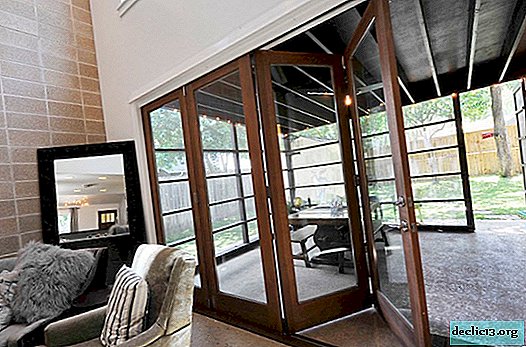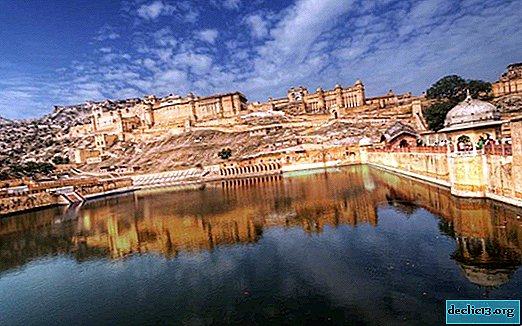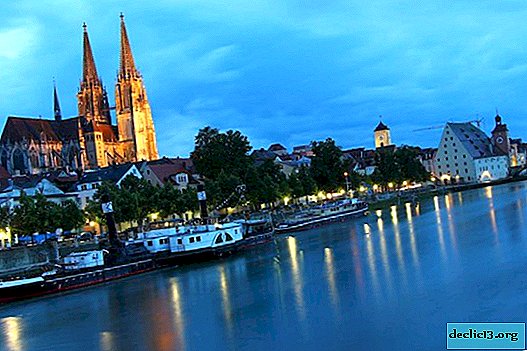Hampi in India - Famous Ruins of Ancient Vijayanagar
Hampi, India is a cult place that is of great importance not only for lovers of ancient architecture, but also for adherents of Hindu dogma. One of the most famous and most visited tourist sites located within this vast country.
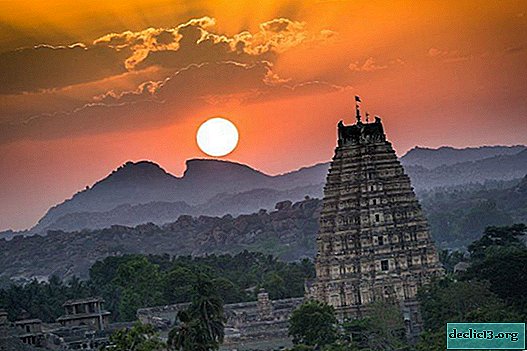
General information
Hampi is a small village located on the banks of the Tungabhadra River (northern part of Karnataka). It is almost 350 km from the city of Bangalore, the capital of this state, and 25 km less from the resorts of Goa. One of the oldest settlements in India is famous for the presence of a large number of the most important architectural attractions, most of which are included in the UNESCO World Heritage List. Despite the long history of its existence, many of them are perfectly preserved to this day, although there are those from which only stones with skillful carvings remained. By the way, the local population is very attentive to their heritage, so some monuments are at the restoration stage.
The first thing that catches your eye when approaching Hampi are huge blocks of stone scattered throughout the neighborhood, and vast rice fields, which are employed by a few local residents. In general, life in this village remained exactly the same as it was many years ago. Men catch fish on the same round bamboo boats as their ancestors, women do children and household work, and pilgrims “beat the thresholds” of ancient Hindu temples dedicated to different gods. And here the annual Vijayanagar Festival and large-scale climbing competitions are held, collecting extreme sports from all over India.

History reference
The history of the famous village is closely connected with Vijayanagar, the former capital of the Vijayanagar empire, on the ruins of which it, in fact, was built. Accordingly, all the monuments, which are the main pride of not only the village itself, but all of India, are nothing more than a part of the ancient city that existed more than 400 years ago (from 1336 to 1565). At that time, the country was divided into several separate kingdoms, which seemed to fall in the house of cards under the pressure of Muslim troops. Vijayanagra became the only Indian principality that could give a worthy rebuff to the enemy. Moreover, it was able to survive even the era of the Delhi Sultanate, known for its irreconcilable attitude to the representatives of Hinduism.
Over time, the city grew and strengthened so much that it was able not only to annex the entire southern part of India, but also to become one of the richest capitals in the world. Diamonds in the city bazaar were sold in kilograms, palaces were studded with pure gold, and the streets were decorated with beautiful temples, statues of Hindu deities and magnificent rose gardens, for the construction of which the local builders had to change the riverbed.

Already then, in the 14-16 centuries, there was a sewage system and a water supply system in Vijayanagra, and the city itself was guarded by a 40-thousand army and 400 fighting elephants, sharp swords attached to tusks of which. Scientists claim that during its heyday, the area of the Vijayanagar capital was up to 30 square meters. km, and the population reached 500 thousand people. At the same time, they settled according to a certain principle: the richer and closer to the king, the closer to the center.
But all this has sunk into oblivion after the battle of Talikot, which the local army devastatingly lost to the Islamic forces. After that battle, from the once strong and rich empire there were only majestic ruins scattered over 30 km of the territory.
What can you see in Hampi today?
There are a number of truly unique sights in Hampi that will take at least 2 days to explore. As part of this article, we will describe only the main ones.
Virupaksha Temple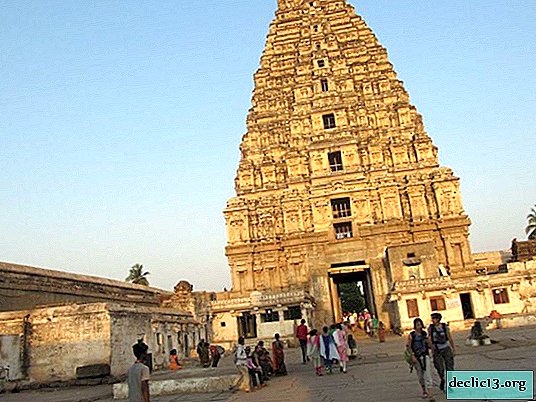
Looking at the photos of Hampi (India) in tourist avenues, you probably noticed a majestic temple complex dedicated to the god Shiva. This is not only the largest, but also the most ancient architectural monument that existed in the Vijayanagar empire. Visitors to the temple, the entrance to which is indicated by a huge gopurama (gate), meets the goddess in the guise of an elephant. She will give you puja and bless you for good undertakings.
Unlike other Indian gopurams, the gates in Virupaksha Temple abound not only with sculptures of various Indian deities, but also with scenes of erotic content. The territory of the complex is striking in its scale. In addition to the sanctuary itself, it has a swimming pool, kitchen and royal chambers. Under the main building, the Tungabhadra River flows, associated with the wife of Virupaksha - Pampa.
At the beginning of the 19th century the temple has been completely restored. Currently, he annually hosts a huge number of pilgrims who come here from all over India. Moreover, the largest number of visitors is celebrated in December, when a traditional wedding festival is held in Hampi.
Vittal Temple
Vittala Temple, located next to the village market and dedicated to the supreme deity Vishnu, is considered the most beautiful building of the Vijayanagar ruins. The main characteristic feature of this temple is the singing mini-columns, reproducing all 7 notes no worse than some musical instrument (56 in total). The inner halls of the sanctuary are decorated with unusual figures of musicians and dancers, and one of the halls, called the hall of a hundred columns, served for wedding ceremonies. Scientists say that in earlier times, both Vittala himself and the chariot before him were painted with mineral-based paint, which protected them from the sun and rain. Perhaps that is why both structures are well preserved to this day.
Stone chariot
The stone chariot or Stone Chariot has long become the most important symbol of Hampi. Designed for the movement of the supreme gods, it was created from separate blocks - and with such accuracy and skill that the joints between the stones can not be distinguished. The quadriga wheels are in the form of a lotus and can quietly rotate around its axis. According to one of the local legends, everyone who was able to scroll through these gears acquired various religious merits. True, several years ago they were reliably recorded, trying to protect not only from curious tourists, but also from religious fanatics. Sacred elephants carry Stone Chariot, the size of which is significantly inferior to the burden placed on them.
 Monolith Narasimha
Monolith NarasimhaAn equally famous attraction of Hampi (India) is the 7-meter-high statue of Narasimha, carved from a rock monolith in 1673. Dedicated to the next incarnation of Vishnu, this statue is a man with the head of a lion, immersed in a state of deep trance. It has long been believed that the monolith of Narasimha has divine power and protects the inhabitants of Vijayanagra from various adversities. For some reason, the Muslims left this sculpture intact, so now it is in almost perfect condition.
Lotus palace
Lotus Mahal, resembling an ajar lotus bud, is considered the most beautiful building of the so-called women's quarter. The purpose of this magnificent pavilion remains unclear, but it was clearly secular in nature and most likely served for the rest of the court ladies. In the architecture of this building, you can notice both Indian and Arabic motifs. Both floors of the palace are designed so that the wind walks inside the premises, and above the window openings you can still see special hooks holding the curtains.
Royal elephant
Royal Elephant House, which was home to the best royal elephants, has 11 spacious chambers crowned with tall Muslim domes. It is believed that in the elephant’s central hall there was a court orchestra, in the concerts of which not only musicians participated, but also the elephants themselves. There even preserved metal mounts for which protruding animals were tied. Near the stalls there is a pool and fountains in which tired elephants quench their thirst.
Monkey Temple
An overview of the main attractions of the ancient city of Hampi is completed by a small Hindu sanctuary located on the top of Matanga. You can get to it by stone steps, which the pilgrims prefer to walk barefoot. This building itself, perhaps, is no different from many other objects scattered around the country. But believe me, in no other corner of India you will not see so many wild monkeys and such an incredibly beautiful sunset, the impression of which enhances the view of the ancient city ruins. Climbing the mountain is best after 17:00 when the heat subsides.
How to get from Goa?
If you do not know how to get from North Goa to Hampi (India), use one of the following methods.
By train
Many tourists prefer the night train, which has everything for a comfortable trip. You can board it at 2 stations: Vasco-Da-Gama (if you eat from the north of Goa) and Margao (if from the south). The train arrives at Hospit station around noon. Next you need to take a taxi or hire a motor rickshaw. One way ticket costs about $ 20.
The current schedule can be found on the official website of the Indian Railway www.indianrail.gov.in
By busBetween Hampi and Goa, there are several regular buses that belong to different carrier companies. Flights depart from the central bus stations of Bangalore and Panaji (at night, at 19:00). At the same time, the "Sleeper Bus", equipped with folding seats, offers the most comfortable conditions. The road to the village takes at least 8 hours. Tickets cost from $ 7 to $ 11, depending on the flight. It is better to buy them on the official website of the company or through a special mobile application. In tourist offices, tickets are 2 times more expensive.
In a rented car with a driverOn a note! Judging by the feedback from members of the forum, the most reliable local carriers are Paulo Travels.

Without exaggeration, this option can be called the most expensive, because you will have to pay at least $ 100 for cars and gasoline. In addition, the roads to Goa are simply terrible, so the road from one state to another will take a lot of time.
With an organized tourAn organized excursion from Goa to Hampi (India) is the easiest and most convenient way. A comfortable bus with tourists leaves late in the evening. The journey takes about 7 hours. The cost of the trip, ranging from $ 80 to $ 110, includes transfer, accommodation in a 3 * hotel, entrance fees to all temples, breakfasts and the services of an experienced Russian-speaking guide. The program, designed for 2 days, includes a trip to the ancient city of Malyavantu and a visit to the magnificent temple complexes dedicated to the Indian gods.
The morning of the next day you will meet on Matanga Hill, which offers a wonderful panorama of the surrounding countryside (at dawn you can take many great photos). Then you will get acquainted with several other religious and architectural monuments, a walk in the ancient bazaar, as well as a trip to the elephant and a small museum dedicated to the history of the Vijayanagar empire.
 Matanga Hill
Matanga HillUseful Tips
Going on a visit to Hampi, India, read the recommendations of those who have already managed to visit this cult place:
- The village has many mini-hotels, so if you want to stay here for a longer period, you will definitely not have problems with housing.
- The most budget accommodation options are located on the left bank of the Tungabhadra. True, in this case, you will have to daily cross to the right side by boat, which leaves every 15-20 minutes, but only goes before sunset.
- Many tourists prefer to settle in Hospet, a small town located 13 km from Hampi. Do not do this. Firstly, travel from one point to another can fly a pretty penny. Secondly, you will deprive yourself of a unique chance to fall asleep and wake up in this atmospheric place.
- The best time to visit the village is from October to March, when the air temperature in India drops to a comfortable 25-27 ° C. If you come here in the midst of summer, grab a lot of water with you and be sure to put on a light headgear - it is next to monoliths heated by the sun and is simply unbearable.
- If you plan to use here-tuk, immediately stipulate the duration of services and price. Usually rickshaws are paid $ 7 per day.
- When gathering in Hampi, stock up on a large number of repellents - due to the proximity of swamps there are a lot of mosquitoes.
- The people of India sacredly honor the traditions of their ancestors and strictly adhere to established rules. In order not to offend anyone, behave more modestly both in the streets and in temples.
- It is most convenient to explore local attractions on a scooter. Renting with gas will cost $ 3-3.5. Behind you can put a local guide - he will show you the way and lead you through the brightest and most interesting places.
- But it is better to refuse a bicycle, especially to those who are not in the best physical condition. The terrain in the village is quite hilly, there is not enough natural shade - it will be very difficult.
- As in North Goa, you cannot go into open Hampi temples shod - in order not to pick up the fungus, bring socks with you.

Visiting the main attractions of the abandoned city of Hampi:

